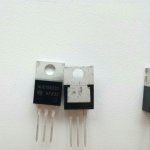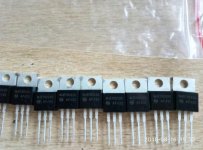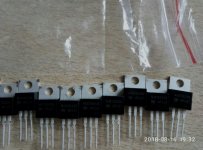from left to right: mouser - 108 board - eBay
None of mine look like the ones you got from Ebay.
Some say that Kiwames are bad, DY294 is bad...
IMHO we are here to share our experience, perhaps it will help some and some will help you with his own better one. This is what I call "forum".
"Yours is bad", with no solution added, doesn't help.
If something is bad, please, point it out and give the solution.
Why do I want to use 2W and 5W resistors? Their heat will be just the same as the original ones but their temperature will be a lot lower.
Which ones are good 2W and 5W resistors you would use?
Which is a tester, in Mouser's catalog, able to measure the breakdown voltage of a transistor?
Awaiting for your kind reply, thank you.
IMHO we are here to share our experience, perhaps it will help some and some will help you with his own better one. This is what I call "forum".
"Yours is bad", with no solution added, doesn't help.
If something is bad, please, point it out and give the solution.
Why do I want to use 2W and 5W resistors? Their heat will be just the same as the original ones but their temperature will be a lot lower.
Which ones are good 2W and 5W resistors you would use?
Which is a tester, in Mouser's catalog, able to measure the breakdown voltage of a transistor?
Awaiting for your kind reply, thank you.
Some say that Kiwames are bad, DY294 is bad...
Nothing wrong with the Dy294. It does what it says on the box.
The Kiwames came to fame in the 90s when most digital sources were quite shrill and parts that could tame that shrillness were held in high regards 🙂 Yes, the paper in oil capacitors had a similar function.
Nothing wrong if you enjoy the way Kiwames sound, as long as you are aware they remove all traces of high frequencies and air in the music 🙂 The 108 sounds mellow enough using neutral components and adding Kiwame will likely push the sound towards the syrupy.
If metal films with the right power rating are not available and you prefer not using wirewounds an acceptable alternative is a parallel combo of lower power metal films. Fwiw, the original 108 uses wire resistors in all the high dissipation spots.
Some say that Kiwames are bad, DY294 is bad...
I’m more curious how you use DY294 to see if a component is fake? I don’t know how to do that. I don’t believe physical similarities are enough to determine if something is fake or not.
I would also spend my money on sourcing from a company I can trust, instead of spending money on measuring instrument especially if a buy a chinese machine to measure fakes. It’s like buying drugtests from your drug dealer. Perhaps you can use the DY294 to match transistors from reliable source?
On the topic of resistors there is a good article in one of the Linear Audio books. In general 1/2 watt resistors had lower THD than regular 1/4 watt. I’m not saying THD is a good way to judge audio qaulity, but the author said that higher power rating improved sound qaulity if the resistor is in the signal path. The difference was just as big if not bigger than the difference between the best and worst performing type of resistor. I don’t know if the gain is that big if you go from 1/2 watt to 2 or 5 Watt.
Guys, you can't identify a fake or an original from the photo. The Chinese make fakes well. Check for a simple break and see the size of the crystal, measure the capacity of the junction b-c, b-e and compare by datasheet. In Russia there is a forum for fakes, here are mine, determine.🙂
Attachments
PHILIPS AC05 39R are wirewires with magnetic legs with unquenched inductance. Here is a review of the resistors that are in the original. So Kiweim is far from the worst.😉
Who has a non-Chinese measuring instrument? Everything in the world is Chinese.😀
This guy 🙂 Made in Germany by himself based on a 1981 article.
A Transistor-Tester with hfe and Breakdown Measurement - YouTube
And you can make a Ruski one if you want to:
TT 7000 Dioden- und Transistortestgerat |
Fachbeitrage | Journal | ELV Elektronik
My point is that it’s hard to know fakes from real ones. Buying from a well known source has higher likelyhood of real ones than visual inspections or measurements.
if they imitate it they do it very well, they seem to be of the same hand
The first two are identical in cases, the second is a little bit worse in Vce breakdown (however within specs) and CE capacity, perhaps both are good originals. I blew a lot of the second kind but I am almost sure it was my fault trying to use a Vbe multiplier. I didn't blow any of the first kind (but I used a solution far better than the Vbe multiplier).
The third has a different case and marks. It is a disaster in Vce breakdown and Vcesat; its CE capacity is one third than the good one. I lost the count of how many I blew trying to have the 108 work, when approaching the 100Vdc with the variac. I will trash all of them.
Nothing wrong with the Dy294. It does what it says on the box.
The Kiwames came to fame in the 90s when most digital sources were quite shrill and parts that could tame that shrillness were held in high regards 🙂 Yes, the paper in oil capacitors had a similar function.
Nothing wrong if you enjoy the way Kiwames sound, as long as you are aware they remove all traces of high frequencies and air in the music 🙂 The 108 sounds mellow enough using neutral components and adding Kiwame will likely push the sound towards the syrupy.
If metal films with the right power rating are not available and you prefer not using wirewounds an acceptable alternative is a parallel combo of lower power metal films. Fwiw, the original 108 uses wire resistors in all the high dissipation spots.
I perfectly understand your explanation that matches with what I knew, at that time, about paper oil capacitors. A sound I never liked and I thought something was wrong with me. I never used any Kiwame but all audiophile were enthusiastic about them and their price, at least in Italy, was very high. Now they are very affordable and I kow why. Thank you! And thaks to all others helping on this topic.
I would like to use all PR9372 resistors but their maximum power is 1W. And don't like that much the parallel solution in a PCB. So I think, after your suggestion, I will use metal film Vishay resistors for higher power ones. Better stuff has crazy price, even over $50 apiece. What about metal-oxide resistors that, for what I know, are very stable in temperature?
This guy 🙂 Made in Germany by himself based on a 1981 article.
A Transistor-Tester with hfe and Breakdown Measurement - YouTube
And you can make a Ruski one if you want to:
TT 7000 Dioden- und Transistortestgerat |
Fachbeitrage | Journal | ELV Elektronik
My point is that it’s hard to know fakes from real ones. Buying from a well known source has higher likelyhood of real ones than visual inspections or measurements.
The Rusky has not reported any feature about measuring the V breakdown, which is the first important discriminating information between good/fake, being the second one the CE capacity.
The point is that you have some stuff, in your small drawers, bought from everywhere and you have doubts about fakes. So you need something able to discriminate true from fake pieces. With the DY294 I could find out that all MJE1503x I bought in eBay are fake ones, that all MJE340/350 I bought in eBay are good ones as well all 2N5551/5401 I bought in eBay. Finally, all transistors bought in Mouser and Digi-Key are all good ones.
Hoever, for the future, I will avoid buying components in eBay. Only Mouser and Digikey that serve the US in a very good way.
What about metal-oxide resistors that, for what I know, are very stable in temperature?
I avoid these with the same fervor i avoid ceramic caps.
Soundwise, and perhaps in measurable distortion, nothing is safer than metal films. Now and then you get resistors using other tech like the tantalum, carbon film or wire that have appealing sonic flavours but i feel their sonic signatures are more apparent than good metal films.
Thank you!
With you about ceramic caps, I use only silver-mica ones.
I will check where are now the PCBs I bought from Ali and, if they passed the US customs, I will place orders for all metal film resistors.
With you about ceramic caps, I use only silver-mica ones.
I will check where are now the PCBs I bought from Ali and, if they passed the US customs, I will place orders for all metal film resistors.
RWM Sfernice (Vishay) are not that pricey and are available in farnell. They come in 3W, 5W, 7W and perhaps more. Soundwise are quite OK 😉
Thank you for your suggestion. These are wire wound resistors, that I would like to avoid. But most of you keep saying they are good.
The 2W resistors I need are not substitution of 0.5W ones to have them bigger. All 0.5W will be the red ones PR9372 0.5W. I only need to replace the 36Ohm resistors because, at 140V, they are crossed by 82mA each, that is 250mW in heat; so better have them bigger than 500mW as the original (250mW on Chinese board), even because I will modify the stage trying to use a Baxandall super pair, then some more current is expected to flow in these resistors.
I recalculated the value of the 2W resistors to be suitable with 140V and their power does not need to increase, 2W are still ok.
Then I need 10W resistors for the added NSCB stage, where, now, 2x two paralleled 5W metal oxide are used.
Even if I have low-quality components (Chinese metal oxide, Wima, and so on) in my WHA-217:
I was listening to some audiophile recording (female voice and piano) one hour ago and I was impressed by the fact that they seemed to be present in front of me. It is the third time in my life, the first was a lot of years ago, while listening, from the open door of the room, my friend Franco playing the guitar. I didn't have the full view of the room, I only could see the speakers but not completely Franco. I thought to myself he was very good, I didn't know he was a so good guitar player. Actually he wasn't! He was only holding the guitar but the sound came from vinyl. The amplifier and the speakers were RCF, Italian brand, very low-end components. Despite the low-end stuff, it was a clear example of absence of temporal distortion (audio concept) never felt again, not even in the best of the best ultra-hi-end audio chain I have heard. The other two times were at home, with my Acoustat 1+1 and the WHA-217.
But I know it could be even better so that's why I want to try asap the 3SSS' suggestion about Baxandall super pair. The 108's PCBs landed in the US but they are still on their way to the customs so I have to be patient.
Coming back to resistors:
I'm having a hard time searching for metal film 2W and 5W resistor, they do not exist at a reasonable price, not in Mouser, nor in Digi-Key nor in Farnell (Newark here in the US). I have tons of them in my lab in Rome but I'm in Utah now and here I have tons of metal oxide. But they seem to be not that good.
What are the members' suggestions? Should I use wire wound resistors? I used a couple of them in my preamplifier, but only to trim the heathers voltage. Are they better than metal oxide ones?
The 2W resistors I need are not substitution of 0.5W ones to have them bigger. All 0.5W will be the red ones PR9372 0.5W. I only need to replace the 36Ohm resistors because, at 140V, they are crossed by 82mA each, that is 250mW in heat; so better have them bigger than 500mW as the original (250mW on Chinese board), even because I will modify the stage trying to use a Baxandall super pair, then some more current is expected to flow in these resistors.
I recalculated the value of the 2W resistors to be suitable with 140V and their power does not need to increase, 2W are still ok.
Then I need 10W resistors for the added NSCB stage, where, now, 2x two paralleled 5W metal oxide are used.
Even if I have low-quality components (Chinese metal oxide, Wima, and so on) in my WHA-217:
I was listening to some audiophile recording (female voice and piano) one hour ago and I was impressed by the fact that they seemed to be present in front of me. It is the third time in my life, the first was a lot of years ago, while listening, from the open door of the room, my friend Franco playing the guitar. I didn't have the full view of the room, I only could see the speakers but not completely Franco. I thought to myself he was very good, I didn't know he was a so good guitar player. Actually he wasn't! He was only holding the guitar but the sound came from vinyl. The amplifier and the speakers were RCF, Italian brand, very low-end components. Despite the low-end stuff, it was a clear example of absence of temporal distortion (audio concept) never felt again, not even in the best of the best ultra-hi-end audio chain I have heard. The other two times were at home, with my Acoustat 1+1 and the WHA-217.
But I know it could be even better so that's why I want to try asap the 3SSS' suggestion about Baxandall super pair. The 108's PCBs landed in the US but they are still on their way to the customs so I have to be patient.
Coming back to resistors:
I'm having a hard time searching for metal film 2W and 5W resistor, they do not exist at a reasonable price, not in Mouser, nor in Digi-Key nor in Farnell (Newark here in the US). I have tons of them in my lab in Rome but I'm in Utah now and here I have tons of metal oxide. But they seem to be not that good.
What are the members' suggestions? Should I use wire wound resistors? I used a couple of them in my preamplifier, but only to trim the heathers voltage. Are they better than metal oxide ones?
Last edited:
those are excellent
- TE Connectivity / Holsworthy -
- TE Connectivity / CGS -
- Ohmite -
- Vishay / Dale -
, by Mouser, thick film, readily available
- TE Connectivity / Holsworthy -
- TE Connectivity / CGS -
- Ohmite -
- Vishay / Dale -
, by Mouser, thick film, readily available
Last edited:
- Home
- Amplifiers
- Solid State
- Dartzeel amp schematic - build this?


